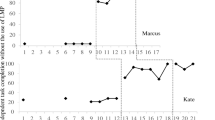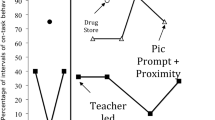Abstract
Strategies that promote the independent demonstration of skills across educational settings are critical for improving the accessibility of general education settings for students with ASD. This research assessed the impact of an individual work system on the accuracy of task completion and level of adult prompting across educational setting. Student accuracy and adult prompting were measured in both special and general education settings during academic work periods. Work systems, an element of structured teaching developed by Division TEACCH, are organized sets of visual information that inform a student about participation in work areas. A multiple-probe-across-participants design was used to evaluate the effects of the individual work systems. All participants demonstrated increased accuracy yet required less adult support across special and general education settings. Results were maintained when measured during a 1-month follow-up probe.



Similar content being viewed by others
References
Adcock, J., & Cuvo, A. (2009). Enhancing learning for children with autism spectrum disorders in regular education by instructional modifications. Research in Autism Spectrum Disorders, 3, 319–328.
Ayres, K., Maguire, A., & McClimon, D. (2009). Acquisition and generalization of chained tasks taught with computer based video instruction to children with autism. Education and Training in Autism and Developmental Disabilities, 44, 493–508.
Bennett, K., Reichow, B., & Wolery, M. (2011). Effects of structured teaching on the behavior of young children with disabilities. Focus on Autism and Other Developmental Disabilities, 26, 143–152.
Boutot, A., & Hume, K. (2012). Beyond time out and table time: Today‘s applied behavior analysis for students with autism. Education and Training in Autism and Developmental Disabilities. 47, 23–38.
Bucklin, B., Dickinson, A., & Brethower, D. (2000). A comparison of the effects of fluency training and accuracy training on application and retention. Performance Improvement Quarterly, 13, 140–163.
Cashin, A., & Barker, P. (2009). The triad of impairment in autism revisited. Journal of Child and Adolescent Psychiatric Nursing, 22, 189–193.
Chapman, S., Ewing, C., & Mozzoni, M. (2005). Precision teaching and fluency training across cognitive, physical, and academic tasks in children with traumatic brain injury: A multiple baseline study. Behavioral Interventions, 20, 37–49.
Cohen, J. (1968). Weighted kappa: Nominal scale agreement provision for scaled disagreement or partial credit. Psychological Bulletin, 40, 213–220.
Dettmer, S., Simpson, R., Myles, B., & Ganz, J. (2000). The use of visual supports to facilitate transitions of students with autism. Focus on Autism and Other Developmental Disabilities, 15, 163–170.
Fein, D., Tinder, P., & Waterhouse, L. (1979). Stimulus generalization in autistic and normal children. Journal of Child Psychology and Psychiatry, 20, 325–335.
Garretson, H., Fein, D., & Waterhouse, L. (1990). Sustained attention in children with autism. Journal of Autism and Developmental Disorders, 20, 101–114.
Goodson, J., Sigafoos, J., O’ Reilly, M., Cannella, H., & Lancioni, G. (2007). Evaluation of a Video-based error correction procedure for teaching a domestic skill to individuals with developmental disabilities. Research in Developmental Disabilities, 28, 458–467.
Gray, C. (2004). Understanding cognitive development: Automaticity and the early years child. Child Care in Practice, 10, 39–47.
Green, G. (2001). Behavior analytic instruction for learners with autism: Advances in stimulus control technology. Focus on Autism and Other Developmental Disabilities, 16, 72–85.
Hall, L. (2009). Autism spectrum disorders: From theory to practice. Upper Saddle River, NJ: Pearson.
Heflin, J., & Alberto, P. (2001). Establishing a behavioral context for learning for students with ASD. Focus on Autism and Other Developmental Disabilities, 16, 93–102.
Holifield, C., Goodman, J., Hazelkorn, M., & Heflin, J. (2010). Using self-monitoring to increase academic attending to task and academic accuracy in children with autism. Focus on Autism and Other Developmental Disabilities, 25, 230–238.
Horner, R., & Baer, D. (1978). Multiple-probe technique: A variation of the multiple baseline. Journal of Applied Behavior Analysis, 11, 189–196.
Horner, R., Carr, E., Halle, J., McGee, G., Odom, S., & Wolery, M. (2005). The use of single-subject research to identify evidence-based practice in special education. Exceptional Children, 71, 165–179.
Hume, K., Loftin, R., & Lantz, J. (2009). Increasing independence in autism spectrum disorders: A review of three focused interventions. Journal of Autism and Developmental Disorders, 39, 1329–1338.
Hume, K., & Odom, S. (2007). Effects of an individual work system on the independent functioning of students with autism. Journal of Autism and Developmental Disorders, 37, 1166–1180.
Kleeberger, V., & Mirenda, P. (2010). Teaching generalized imitation skills to a preschooler with autism using video modeling. Journal of Positive Behavior Interventions, 12, 116–127.
Koegel, L., Koegel, R., Frea, W., & Green-Hopkins, I. (2003). Priming as a method of coordinating educational services for students with autism. Language, Speech, & Hearing Services in Schools, 34, 228–235.
Lopez, B., & Leekam, S. (2003). Do children with autism fail to process information in context? Journal of Child Psychology and Psychiatry, 44, 285–300.
MacDuff, G., Krantz, P., & McClannahan, L. (1993). Teaching children with autism to use photographic activity schedules: Maintenance and generalization of complex response chains. Journal of Applied Behavior Analysis, 26, 89–97.
Massaro, D. W., & Bosseler, A. (2006). Read my lips: The importance of the face in a computer animated tutor for vocabulary learning by children with autism. Autism, 10, 495–510.
Mechling, L., Gast, D., & Seid, N. (2009). Using a personal digital assistant to increase independent task completion by students with autism spectrum disorder. Journal of Autism and Developmental Disorders, 39, 1420–1434.
Mesibov, G., Shea, V., & Schopler, E. (2005). The TEACCH approach to autism spectrum disorders. New York: Plenum Press.
Murphy, R., & Bryan, A. (1980). Multiple baseline and multiple-probe designs: Practical alternatives for special education assessment and evaluation. The Journal of Special Education, 14, 327–335.
Odom, S., Collet-Klinenberg, L., Rogers, S., & Hatton, D. (2010). Evidence-based practices in interventions for children and youth with autism spectrum disorders. Preventing School Failure, 54, 275–282.
Pelios, L., MacDuff, G., & Axelrod, S. (2003). The effects of a treatment package in establishing independent work skills in children with autism. Education and Treatment of Children, 26, 1–21.
Plaisted, K. (2001). Reduced generalization in autism: An alternative to weak central coherence. The development of autism: Perspectives from theory and research. In J. Burack, T. Charman, N. Yirmiya, & P. Zelazo (Eds.), The Development of Autism: Perspectives from Theory and Research (pp. 149–169). Mahwah, NJ: Lawrence Erlbaum Associates Publishers.
Samuels, C. (2011). Finding efficiencies in special education programs. Education Week, 30, 32–34.
Sanford, C., Levine, P., & Blackorby, J. (2008). A National profile of students with autism: A special topic report from the special education elementary longitudinal study (SEELS). Office of Special Education Programs, U.S. Department of Education. Retrieved on June 9, 2011 from http://www.seels.net/info_reports/SEELS_STRAutism.12.19.08ww_.pdf.
Scheuermann, B., Webber, J., Boutot, A., & Goodwin, M. (2003). Problems with personnel preparation in autism spectrum disorders. Focus on Autism and Other Developmental Disabilities, 18, 197–206.
Schopler, E., Mesibov, G., & Hearsey, K. (1995). Structured teaching in the TEACCH system. In E. Schopler & G. Mesibov (Eds.), Learning and cognition in autism (pp. 243–268). New York: Plenum Press.
Schopler, E., Reichler, J., & Renner, B. (1988). The childhood autism rating scale. Los Angeles: Western Psychological Services.
Scruggs, T., & Mastropieri, M. (1994). The utility of the PND statistic: A reply to Allison and Gorman. Behaviour Research and Therapy, 32, 879–883.
Smith, T. (2001). Discrete trial training in the treatment of autism. Focus on Autism and Other Developmental Disabilities, 16, 86–92.
Stahmer, A., & Schreibman, L. (1992). Teaching children with autism appropriate play in unsupervised environments using a self-management package. Journal of Applied Behavior Analysis, 25, 447–459.
Stokes, T., & Baer, D. (1977). An implicit technology of generalization. Journal of Applied Behavior Analysis, 10, 349–367.
Tabor, T., Seltzer, A., Heflin, J., & Alberto, P. (1999). Use of self-operated auditory prompts to decrease off-task behavior for a student with autism and moderate mental retardation. Focus on Autism and Other Developmental Disabilities, 14, 159–168.
Thurm, A., Lord, C., Li-Ching, L., & Newschaffer, C. (2007). Predictors of language acquisition in preschool children with autism spectrum disorders. Journal of Autism and Developmental Disorders, 37, 1271–1734.
U.S. Department of Education Data Accountability Center. (2006). Retrieved June 12, 2011 from website https://www.ideadata.org/DataProfiles.asp.
Wolf, M. (1978). Social validity: The case for subjective measurement or how applied behavior analysis is finding its heart. Journal of Applied Behavior Analysis, 11, 124–203.
Yianni-Coudurier, C., Darrou, C., Lenoir, P., Verrecchia, B., Assouline, B., et al. (2008). What clinical characteristics of children with autism influence their inclusion in regular classrooms? Journal of Mental Deficiency, 52, 855–863.
Author information
Authors and Affiliations
Corresponding author
Additional information
This research was completed as part of the first author’s doctoral dissertation at Indiana University.
Appendix
Appendix
Social Validity Measure for Staff–Pre
Please circle the statement that most closely describes your reactions to the following statements.
1. Independence is one area where my student needs to improve | ||||
AGREE | SLIGHTLY AGREE | NEUTRAL | SLIGHTLY DISAGREE | DISAGREE |
2. Increasing my student’s accuracy when completing tasks is an important goal | ||||
AGREE | SLIGHTLY AGREE | NEUTRAL | SLIGHTLY DISAGREE | DISAGREE |
3. My student uses skills in more than one setting | ||||
OFTEN | SOMETIMES | NEUTRAL | RARELY | NEVER |
4. My student can be taught a way to work more independently | ||||
AGREE | SLIGHTLY AGREE | NEUTRAL | SLIGHTLY DISAGREE | DISAGREE |
5. My student demonstrates off-task behavior | ||||
OFTEN | SOMETIMES | NEUTRAL | RARELY | NEVER |
6. The ability to generalize skills to other settings is an important goal for my student | ||||
AGREE | SLIGHTLY AGREE | NEUTRAL | SLIGHTLY DISAGREE | DISAGREE |
7. My student works without prompts | ||||
OFTEN | SOMETIMES | NEUTRAL | RARELY | NEVER |
Social Validity Measure for Staff–Post
1. My student’s independence increased with his participation in this study | ||||
AGREE | SLIGHTLY AGREE | NEUTRAL | SLIGHTLY DISAGREE | DISAGREE |
2. My student’s off-task behavior was reduced | ||||
AGREE | SLIGHTLY AGREE | NEUTRAL | SLIGHTLY DISAGREE | DISAGREE |
3. My student was able to generalize skills across setting | ||||
AGREE | SLIGHTLY AGREE | NEUTRAL | SLIGHTLY DISAGREE | DISAGREE |
4. When my student became more independent, teacher prompts decreased | ||||
AGREE | SLIGHTLY AGREE | NEUTRAL | SLIGHTLY DISAGREE | DISAGREE |
5. My student became more accurate in his work | ||||
AGREE | SLIGHTLY AGREE | NEUTRAL | SLIGHTLY DISAGREE | DISAGREE |
Rights and permissions
About this article
Cite this article
Hume, K., Plavnick, J. & Odom, S.L. Promoting Task Accuracy and Independence in Students with Autism Across Educational Setting Through the Use of Individual Work Systems. J Autism Dev Disord 42, 2084–2099 (2012). https://doi.org/10.1007/s10803-012-1457-4
Published:
Issue Date:
DOI: https://doi.org/10.1007/s10803-012-1457-4




